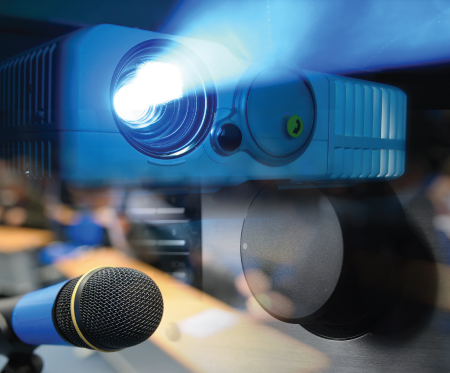Pro strategies for choosing audio visual charlotte nc providers
Understanding the Incorporation of Audio Visual Innovation in Today's Educational Environments
The assimilation of audio-visual innovation in instructional settings has changed the training and learning process. Educators currently have access to tools that satisfy various finding out styles, improving student interaction and cooperation. Nevertheless, the consolidation of these innovations provides both possibilities and obstacles. Understanding how to effectively apply these tools is vital. What methods can educators use to maximize the advantages of audio-visual innovation in their classrooms?
The Development of Audio-Visual Innovation in Education
As instructional demands progressed over the years, audio-visual innovation undertook significant makeovers that reshaped the understanding setting. Initially, devices such as movie projectors and slide shows were the main means of integrating visual elements into class. These early modern technologies provided educators with the ability to existing details dynamically, yet they were limited in availability and interactivity.
With the arrival of video clip cassette recorders in the 1970s, class started to incorporate taped lessons, expanding the scope of academic sources. The introduction of desktop computers in the 1980s additional revolutionized this landscape, allowing for the production of multimedia presentations and interactive discovering experiences.
The surge of the net in the 1990s noted a turning point, allowing real-time access to a wealth of audio-visual materials. Today, electronic devices such as interactive white boards and on the internet knowing platforms proceed to enhance the educational experience, fostering involvement and partnership among students.
Benefits of Audio-Visual Tools for Diverse Knowing Styles
Audio-visual tools play a necessary function in accommodating varied discovering styles by boosting visual discovering and enhancing auditory engagement. By incorporating photos, video clips, and noise, these modern technologies develop a more comprehensive academic environment. This diverse technique allows instructors to resolve the different preferences and needs of pupils effectively.
Enhancing Visual Understanding
Engagement in the knowing procedure is noticeably improved through the usage of audio-visual tools, accommodating numerous learning styles. These devices, such as videos, infographics, and interactive presentations, provide aesthetic stimulations that assist comprehension and retention. Aesthetic students, particularly, gain from the consolidation of images and computer animations, which can simplify complex ideas and enhance understanding. Furthermore, audio-visual sources can highlight real-world applications, making learning a lot more pertinent and engaging. By incorporating color, activity, and audio, teachers can create a vibrant discovering atmosphere that records pupils' focus and promotes much deeper cognitive links. Ultimately, the tactical use audio-visual modern technology not only supports visual learning but likewise enhances the overall academic experience for varied students.
Improving Auditory Engagement
A considerable benefit of including audio-visual devices in education and learning is their capacity to enhance auditory engagement among students. These tools, which include multimedia presentations, podcasts, and interactive audio elements, satisfy various finding out styles, specifically benefiting acoustic students (audio visual charlotte nc). By incorporating sound and narrative, educators can create immersive experiences that record pupils' focus and strengthen understanding. This engagement is essential, as it cultivates a much deeper understanding of the material and promotes retention. In addition, audio-visual devices can facilitate collaborative discovering environments, urging pupils to take part in discussions and share their insights. Eventually, the consolidation of audio-visual technology not just sustains auditory engagement yet additionally enhances the total instructional experience, making discovering more dynamic and effective for all pupils
Enhancing Involvement With Interactive Discovering

Gamification components, such as tests and simulations, can enhance inspiration and retention, making learning a lot more pleasurable and effective. These techniques not only boost cognitive engagement yet likewise cater to varied discovering styles, making sure that all pupils can participate meaningfully. Consequently, interactive learning settings cultivate a sense of area and belonging, ultimately causing enhanced academic results. With the integration of audio aesthetic modern technology, teachers can transform conventional classrooms right into dynamic areas where pupils grow and actively shape their academic trips.
Bridging Concept and Experiment Multimedia Resources
Multimedia resources act as a critical link between theoretical principles and functional application in instructional setups. By improving interaction, assisting in collective discovering experiences, and sustaining diverse knowing styles, these devices create a more inclusive and dynamic understanding setting - audio visual charlotte nc. This approach not only fosters deeper understanding but additionally prepares trainees for real-world obstacles

Enhancing Involvement With Multimedia
Involvement in educational settings substantially increases when trainers incorporate multimedia resources into their mentor methods. Using videos, podcasts, and interactive discussions boosts the learning experience, enabling trainees to attach with the material on multiple levels. Multimedia resources satisfy different discovering designs, providing visual, auditory, and kinesthetic stimuli that can hold pupils' attention much more successfully than typical lecture techniques. Furthermore, these resources can streamline complicated principles, making them more obtainable and remarkable. By incorporating multimedia, teachers can develop a vibrant classroom atmosphere that fosters curiosity and motivates students. Inevitably, the strategic usage of audio-visual innovation serves to bridge the void between academic knowledge and sensible application, improving the academic experience for both instructors and students.
Facilitating Collaborative Knowing Knowledge
Many research studies suggest that joint learning experiences substantially enhance student outcomes when incorporated with multimedia resources. Multimedia devices facilitate communication among students, permitting them to involve in analytic and vital believing jointly. By making use of video clip conferencing, collective systems, and interactive discussions, educators produce environments for synergy and shared learning. These innovations enable pupils to communicate their concepts effectively and obtain instant comments, cultivating a deeper understanding of the topic. Furthermore, multimedia sources can provide complicated ideas in even more absorbable styles, advertising conversation and collaboration. Consequently, the combination of collective discovering and audio-visual technology not just enriches the educational experience yet additionally prepares trainees for real-world synergy dynamics, stressing the value of collaboration and collective knowledge building.
Supporting Diverse Knowing Styles
While typical teaching methods typically accommodate a minimal array of learning choices, the integration of audio-visual innovation provides a much more inclusive strategy to education. By employing multimedia resources such as video clips, interactive simulations, and electronic presentations, instructors can resolve numerous discovering designs, consisting of visual, acoustic, and kinesthetic. This adaptability enables for differentiated direction, enabling students to involve with material in manner ins which resonate with their private choices. Furthermore, audio-visual tools can promote much deeper understanding by supplying numerous depictions of complex principles. Because of this, pupils that might struggle with standard methods can find alternate paths to success, promoting a more fair learning environment that supports scholastic accomplishment for all students.
Challenges in Executing Audio-Visual Innovation
Audio-visual modern technology holds wonderful promise for enhancing academic experiences, its implementation often runs into substantial difficulties. One key problem is the financial problem related to purchasing and keeping such equipment, which can strain budget plans, specifically in underfunded establishments. In addition, poor training for educators can impede reliable combination, leaving them ill-prepared to make use of the innovation totally. Technical issues, such as software program breakdowns and compatibility issues, may also interrupt lessons and irritate both teachers and students. Differing degrees of trainee accessibility to technology outside the class can create differences in learning opportunities. Finally, the possibility for over-reliance on technology may take away from essential teaching methods, eventually limiting the educational experience. Dealing with these challenges calls for a comprehensive approach, including ample funding, expert growth, and fair access to sources, to assure that audio-visual innovation can be leveraged efficiently in today's educational settings.
Ideal Practices for Integrating Technology in the Class

Furthermore, promoting an interactive atmosphere with joint devices urges pupil interaction and involvement. Using varied audio-visual resources accommodates different finding out styles, accommodating aesthetic, acoustic, and kinesthetic learners. On a regular basis evaluating the impact of modern technology on trainee understanding helps teachers fine-tune their methods and adapt to changing demands. Ultimately, entailing trainees in the choice of innovation promotes possession and inspiration. By adhering to these ideal methods, teachers can create a vibrant classroom atmosphere that effectively incorporates innovation and enhances the educational experience for all pupils.
The Future of Audio-Visual Innovation in Education
As class progressively welcome technology, the landscape of audio-visual devices in education and learning remains to advance (audio visual charlotte nc). Future improvements are expected to concentrate on greater interactivity and customization, enabling educators to customize learning experiences to specific student demands. Developments such as increased truth (AR) and digital reality (VIRTUAL REALITY) will likely supply immersive learning atmospheres, enhancing trainee involvement and understanding
Artificial knowledge (AI) is poised to play a significant duty in audio-visual innovation by offering real-time comments and flexible learning pathways. This combination might read more aid educators determine and attend to pupil challenges better. Cloud-based platforms will assist in less complicated access to resources and collaboration among students and instructors, despite area.
In addition to these technological breakthroughs, specialist development for educators will be important, ensuring they are furnished to make use of these devices effectively. Overall, the future of audio-visual technology in education promises to produce more dynamic, inclusive, and impactful knowing experiences.
Regularly Asked Concerns
Exactly How Can Teachers Select the Right Audio-Visual Tools for Their Classrooms?
Picking suitable audio-visual tools requires teachers to examine their educational objectives, think about pupil requirements, examine offered technology, and look for referrals from peers or specialists, ensuring tools successfully enhance discovering and interaction within their details classroom environment.
What Spending plan Factors to consider Are There for Carrying Out Audio-Visual Innovation?
Budget factors to consider for executing audio-visual technology consist of preliminary purchase prices, maintenance expenditures, training for personnel, and potential software program licensing charges. Furthermore, lasting investment in updates and replacements should also be factored into financial preparation.
Are There Specific Training Resources for Educators on Audio-Visual Equipment?
Many establishments provide training sources for educators on audio-visual tools, consisting of online training courses, workshops, and training overviews. These resources intend to enhance instructors' abilities and self-confidence in efficiently incorporating technology right into their teaching techniques.
How Do We Gauge the Effectiveness of Audio-Visual Innovation in Knowing?
Gauging the effectiveness of audio-visual technology in discovering involves reviewing pupil engagement, understanding, retention prices, and overall scholastic efficiency. Studies, assessments, and empirical researches can offer beneficial insights right into its effect on instructional results.
What Are Common Misunderstandings Regarding Audio-Visual Innovation in Education And Learning?
Typical mistaken beliefs regarding audio-visual innovation in education consist of the idea that it assures engagement and learning end results, in addition to the presumption that all trainees benefit equally, overlooking specific discovering choices and demands.